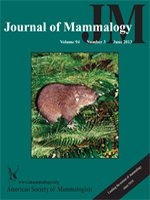Many temperate bat species deal with harsh winter conditions by hibernating. Brief periods of arousal from torpor occur at regular intervals throughout hibernation, although energetically costly. Factors that increase arousal frequency, such as the recently discovered white-nose syndrome (WNS), can thereby greatly decrease survival rates of overwintering bats. Evidence increasingly suggests that evaporative water loss (EWL) may be an important driver of arousal behavior in infected bats. We examined the role that EWL could play in torpor arousals and energy expenditures by developing an individual-based energetics model using EWL as the stimulus for arousal in populations of healthy and WNS-affected little brown myotis (Myotis lucifugus). Our model also examined how EWL could affect spatial distributions of healthy and infected bats within a cave throughout winter. We calculated mean torpor bout duration and survival of populations that inhabited 2 modeled caves typical of both northern and midrange hibernacula. In a northern cave, the mean torpor bout duration was 19.97 days ± 5.49 SD between arousals for healthy bats and 8.60 ± 2.11 days for WNS-affected bats, accompanied by survival rates of 0.80 ± 0.07 SD (healthy) and 0.04 ± 0.02 (infected). In a midrange cave, the mean torpor bout duration was 20.88 ± 6.22 days for healthy bats and 8.88 ± 2.47 for infected bats, and survival rates were 0.98 ± 0.02 (healthy) and 0.55 ± 0.05 (infected). When bats clustered, survival rates increased in both healthy and diseased populations; however, slight changes in relative humidity or the rate of EWL from infected skin counteracted these advantages. We show that, by causing an increase in arousal rates, EWL could play an important role in the pathology of WNS. Additionally, populations experiencing shorter southern winters could persist longer than their northern counterparts when faced with WNS, a fact that could be critical in maintaining viable populations for WNS-vulnerable species.
How to translate text using browser tools
1 June 2013
Evaporative water loss, spatial distributions, and survival in white-nose-syndrome–affected little brown myotis: a model
Sean M. Ehlman,
John J. Cox,
Philip H. Crowley
ACCESS THE FULL ARTICLE

Journal of Mammalogy
Vol. 94 • No. 3
June 2013
Vol. 94 • No. 3
June 2013
caves
Dehydration
disease ecology
Geomyces destructans
hibernation
Latitudinal variation
Myotis lucifugus




